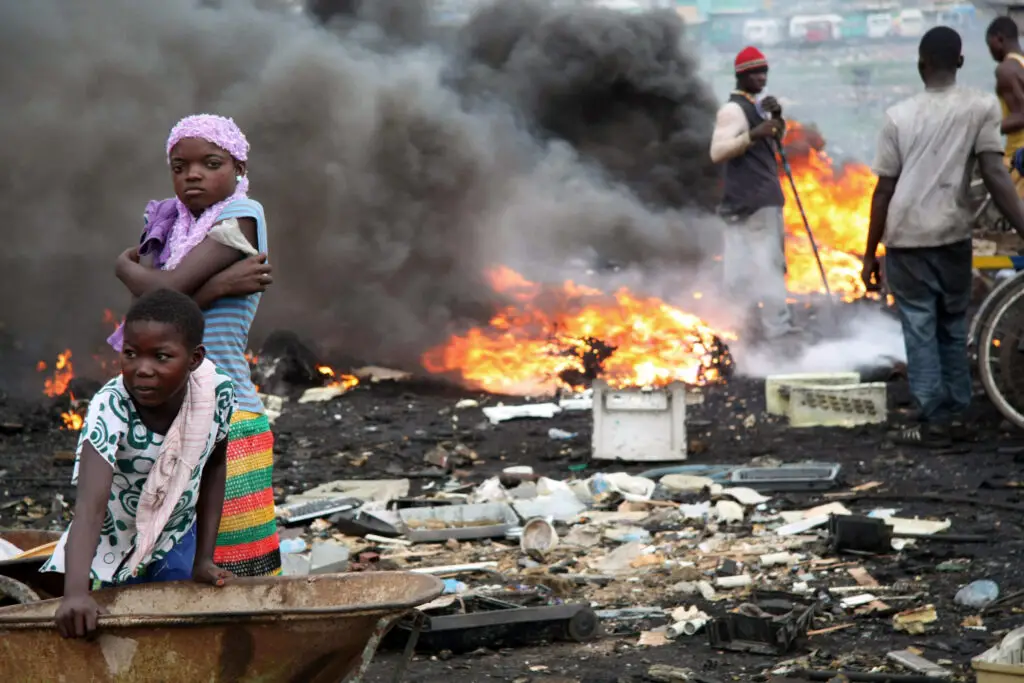- According to UN estimates some 53.6 million tonnes of e-waste was generated around the world in 2019.
- The World Economic Forum (WEF) estimate that the annual generation of e-waste will reach 74.7 Mt by 2030.
- Extended Producer Responsibility (EPR) is a policy or principle that is designed to promote total life cycle of products.
Mobile phone manufacturers release new devices almost every other quarter. Ever wondered what happens to the old ones?
Actually, what happens to old (or not so old) electronics that are simply out-paced by newer technology? Well, just like used cars and clothing, they are exported to Africa and other developing nations.
The so called export of used consumer goods to Africa is nothing more than dumping of electronic waste from rich, developed countries to unsuspecting developing nations that in most cases are forced by loan and grant conditions to buy the environmentally harzadous goods.
Known as Electornic-Waste or E-waste, these are old consumer electronics, the likes of cellphones, laptops, old TVs and anything with a motherboard really are now piling up in landfills all across Africa. In this paradox, developed nations take advantage of the fact that the demand for used electronics is huge in many developing countries for the simple fact that, they are cheap.
Unfortunately, most of these products are irreparable and even in the event that they are, there are simply no readily available technicians to do it. A a result, the electrical devices are thrown away as part of other solid wastes and end up in open dump sites cum harzadous recycle sites.
According to UN estimates some 53.6 million tonnes of e-waste was generated around the world in 2019, that is an average of 7.3 kg of e-waste per person. Worse still, experts at the World Economic Forum (WEF) estimate that the annual generation of e-waste will reach 74.7 Mt by 2030.
Where will all this e-junk go? An e-waste pile in San Jose, Sillicon Valley, Hong Kong? I don’t think so, Africa, seems like the obvious answer.
“Tackling this challenge will require a concerted and coordinated effort from all the organizations and individuals across the electronics value chain,” admits Secretary General of the International Telecommunication Union (ITU), Doreen Bogdan-Martin.
“Manufacturers will need to develop a new approach, and to take responsibility for a product’s entire lifecycle,” suggests in an article titled ‘how Africa is Leading the way in dealing with E-Waste,’ published by the World Economic Forum exactly one year to date.
In the article, the expert cites the Global E-waste Monitor report that purports that 13 countries in Africa already have an e-waste policy, legislation or regulation in place.
“Their efforts can be a lesson to other nations around the world looking to improve their e-waste management systems,” says Bogdan-Martin.
Also Read: Plastic Pandemic: Bans help, recycle funding does more
Pollution for minimum wage: The human recycle plants of Africa
Once the e-waste has been discarded, it almost always ends up in a landfill, an open dump site where trash is collected to form mountains of trash. This is where you will find children and unemployed youth collecting whatever items that can be resold for some change, recycling e-waste in these landfills is in fact their employment and source of livelihood for their families.
According to the Global E-Waste Monitor (2020), the value of the raw materials in e-waste is estimated to $57 billion with iron, copper and gold contributing the highest e-waste material.
With such huge numbers, it is no wonder that in most African countries, recycling and dismantling electronic devices for the precious wires, metals and minerals has become an income generating venture, despite the associated risks.
The recycle items range from plastic bottles and containers to metals and minerals which undergo a process of scraping and burning proved to be hazardous to humans and the environment.
For example, to recycle copper wires, one needs to get the copper wire out of its plastic insulation cover, the quickest and easiest way to do this is by burning the insulation.
“These items are then often scavenged for the purpose of extracting valuable metals by heating and burning, incubating in acids and other methods,” writes Academic Editor Paul B. Tchounwou, in his paper E-Waste in Africa: A Serious Threat to the Health of Children.
The experts notes the 2019 figures, and points out that the recorded e-waste in that year alone contained as much as 50 tons of mercury and 71 tonnes of brominated flame retardants, all extremely harzadous to humans and especially children.
“The improper dumping and recycling of e-waste in several African countries serves as a major source for the release of harmful substances…which pollute soil, water, air, dust, and food sources,” he warns.
In most cases, these dump sites are not in any designated areas. They are right within the vicinity of residential areas. “As a result, children and people living in the surrounding areas are exposed, even if they are not directly involved in the recycling,” he laments.
“Depending on when the insulation was made, the smoke emitted can contain dioxin, heavy metals and other pollutants that pose a strong threat to human health,” explains the writer Adam Minter who visited the world famous Agbogbloshie, a 20-acre plus scrap yard in the heart of Accra, Ghana, it is one of the world’s largest e-waste dump sites.
In his piece ‘The Burning Truth Behind an E-Waste Dump in Africa’ Minter mulls over the burning of automobile tires to collect the steel wiring in them. The burning of insulated copper wire is found in all manner of electrical devices ranging from USBs to refrigerator parts.
Also Read: E-Waste: Africa’s developing electronic catastrophe
Long term solution to E-Waste management
Long term solutions to e-waste management must include components of Extended Producer Responsibility (EPR).
By definition, Extended Producer Responsibility (EPR) is a policy or principle that is designed to promote total life cycle of products by extending the responsibilities of the manufacturer to various parts of the product’s life cycle.
EPR requires producers, manufacturers, importers to take responsibility for the end-of-life management of electronics that they sell.
No matter what level of the value chain, the EPR formula requires responsible parties to either take back their discarded e-waste, recycling them and eventually, when they are no good for recycling, dispose them in a safe and environmentally friendly way.
For EPR to work, then governments must adopt and enforce regulation and policies. The rhetoric must be clear and easy-to-understand, the laws must be stringent and firm. African governments must also support the private sector efforts to establish safe and modern recycle plants for e-waste.
Governments should subsidize importation of equipment, facilitate work visas to ease technology and skill exchange and encourage commercial banks to issue affordable start up and working capital to allow the sub-sector to take off.











